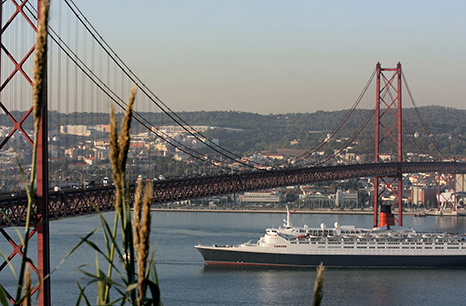LISBON - PORTUGAL - EUROPE
PORT INFORMATION

Photo courtesy Turismo de Lisboa
A lively and upbeat city, Lisbon is Portugal’s largest city and its capital, with the added distinction of being the warmest and westernmost capital in Europe. Its climate is strongly influenced by the Gulf Stream. An earthquake in 1755 levelled a large portion of the city, but those areas were restored and the city retains several of its original medieval neighbourhoods. Built on seven hills, some of Lisbon’s streets are too steep for cars, but cruise visitors can and should take in panoramic views of the city by travelling to the top on elevators or the funicular.
Cruise Terminals in Lisbon, Portugal
The port of Lisbon receives all types of cruise ships, from the smallest to the largest in the world, bringing in more than 400 thousand passengers per year.
The two main cruise terminals in Lisbon can be found near the landmark suspension bridge straddling the estuary about two (2) miles from downtown Lisbon and just over three (3) miles from the old part of town.
Both Cais de Alcántara and the Cais da Rocha Conde de Óbidos piers have well equipped passenger terminals complete with shops, restaurants taxi ranks, and varied other services. There are also a number of floating restaurants close to the cruise terminals.
Access to most attractions is easy by taxi, as is the connection to the airport which is only 10 - 20 minutes away.
Lisbon’s new cruise terminal (with a design focussing on green spaces for use by the local communities as well as cruise ship passengers) will be operating by the end of 2013.
Cruise Lines using the Lisbon Cruise Terminals as an Embarkation / Disembarking Port
A number of major cruise lines operating in Europe use Lisbon in Portugal as a port of embarkation or disembarking. These cruise lines include )Crystal Cruises, Hapag-Lloyd Cruises, Hurtigruten, MSC Cruises, Oceania Cruises, P&O Cruises, Royal Caribbean, Seabourn, Silversea Cruises, Windstar Cruises.Must See Attractions in Lisbon, Portugal
Lisbon’s three cruise terminals are conveniently located in the centre of the city making it easy for cruise guests to reach the city’s many attractions.
City Landmarks: Portugal’s heyday is known as the Age of Discovery, a period during the 15th century when maritime expeditions turned Lisbon into one of the world’s greatest ports and Portugal into an empire. Two of the city’s landmarks – the Tower of Belém, a military construction on the entrance to Tejo River, and the Monastery of Jeróimos, built by King D. Manuel I – celebrate this era. These two buildings are classified as UNESCO World Heritage sites.
Old Neighbourhoods: History is preserved in Lisbon’s distinct neighbourhoods (although modern hotels, nightclubs and restaurants abound). Alfama and Mouraria, medieval neighbourhoods, sit near the ultra modern architecture of the last World Exposition, held in Lisbon in 1998. The Baixa, the city’s downtown area, is home to shops still selling traditional goods.
The Oceanarium: Spend a few hours in the unforgettable company of sharks at the Lisbon Oceanarium, the largest in Europe. Opened in 1998, the Oceanarium was the centerpiece of the XXth Century's last World Fair, themed "The Oceans, a Heritage for the Future".
There is a full range of museums including the National Coach Museum and the Maritime Museum. The Calouste Gulbenkian Planetarium will provide all you want to know of the stars above and the provoking, interactive Pavilion of Knowledge reveals the latest in scientific advances. Try the city zoo with its dolphin shows and lion feeding or, for a better view of the animals, ride the cable car. Finally, relax in one of Lisbon’s Fado Houses to listen to “Fado” – Portugal’s national song, or cruise the Tejo River with views of the Basílica da Estrela and other monuments.
